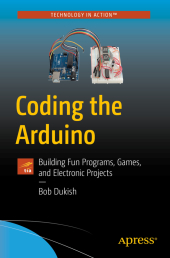 Neuerscheinungen 2018Stand: 2020-02-01 |
Schnellsuche
ISBN/Stichwort/Autor
|
Herderstraße 10
10625 Berlin
Tel.: 030 315 714 16
Fax 030 315 714 14
info@buchspektrum.de |

Bob Dukish
Coding the Arduino
Building Fun Programs, Games, and Electronic Projects
1st ed. 2018. xviii, 294 S. 198 SW-Abb. 235 mm
Verlag/Jahr: SPRINGER, BERLIN; APRESS 2018
ISBN: 1-484-23509-6 (1484235096)
Neue ISBN: 978-1-484-23509-6 (9781484235096)
Preis und Lieferzeit: Bitte klicken
Get started with Arduino and computer coding. This book is intended for those new to the Arduino and computer coding. and looking to gain the skills to write microcontroller programs that can act on given inputs and operate electromechanical output devices.
Coding the Arduino contains four sections: background information, game development, electronic games and projects, and expanded programs. The final chapters expand on the functionality of some of the programs presented in previous chapters, and challenges you with capstone projects.
The projects will be described where the program code that is presented can be modified, or in which two or more of the sample programs may be used to synthesize a new program as the solution to the problem that is presented. Additionally, review questions are presented at the end of each chapter to test your comprehension of the material.
What You´ll Learn
Understand basic principles of technology, and about analog and digital electronics.Create games from scratch, where you interactively play against the program.
Gain an introduction to Artificial Intelligence (AI)
Who This Book Is For
Electronic hobbyists, makers of all levels, and teens with an interest in technology and coding who are looking to get started with Arduinos.
Section One
Chapter 1. A background on technology Section 1.1 The difference between science and technology Section 1.2 Ohm´s Law Section 1.3 Engineering notation
Chapter 2. Computers and the binary system Section 2.1 Digital signals Section 2.2 Power consumption Section 2.3 Interfacing Section 2.4 Pull-ups and pull-downs
Section Two
Chapter 3. Microcontrollers Section 3.1 Describing microcontrollers Section 3.2 Writing a program
Chapter 4. More loops, and more elegant methods to flash an LED Section 4.1 Timer loops Section 4.2 Controlling embedded processes Section 4.3 Digital electronics Section 4.4 Intermittent windshield wiper control with Arduino
Chapter 5. Serial Communications Section 5.1 The binary number system and ASCII code Section 5.2 Simulating artificial intelligence Section 5.3 Designing a serial communications game Section 5.4 A recipe quantity calculator for baked goods
Chapter 6. Having fun with programming Section 6.1 Random teacher jokes Section 6.2 Perfecting random numbers Section 6.3 Poker game Section 6.4 Multi-dimensional arrays Section 6.5 Dice game
Chapter 7. More game programming with a detailed explanation Section 7.1 Coding the game of Twenty One, first attempt Section 7.2 Coding the game of Twenty One, second attempt
Section Three
Chapter 8. Electronic projects Section 8.1 Coding a voltmeter Section 8.2 Dimming an LED with pulse width modulation Section 8.3 Controlling an LED using a light sensor Section 8.4 Coding a frequency counter Section 8.5 Pulse generation Section 8.6 Counter with seven-segment display (with driver) Section 8.7 Dice game with seven-segment display(with driver) Section 8.8 Counter with seven-segment display (no driver) Section 8.9 Dice game with seven-segment display (no driver) Section 8.10 Electronic dice game with individual LEDs
Section Four
Chapter 9. More elaborate projects Section 9.1 Coding a more functional poker game Section 9.2 Coding a more functional game of Twenty One Section 9.3 Using the Arduino to transmit Morse Code
Chapter 10. Capstone Projects Section 10.1 Building an audio Morse code reader Section 10.2 Building an audio Morse code decoder Section 10.3 Team project one, IR Morse code link Section 10.4 Team project two, IR control link Section 10.5 Coding math combination word problems
Appendix A.1 Using and writing libraries A.2 Answers to chapter review questions and projects A.3 Parts list


